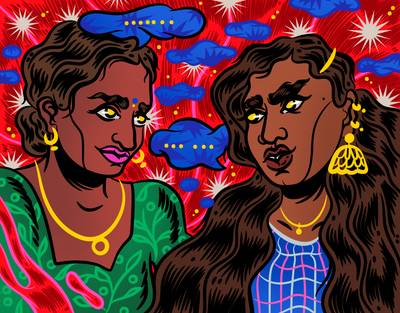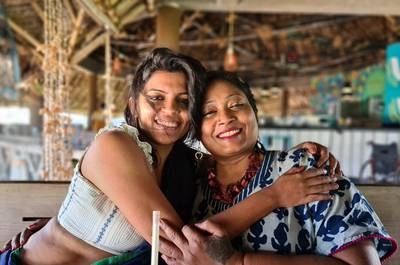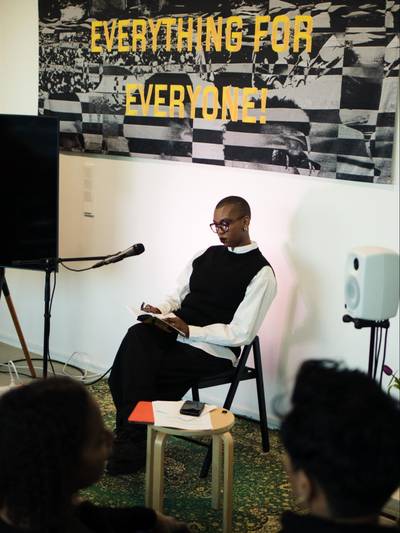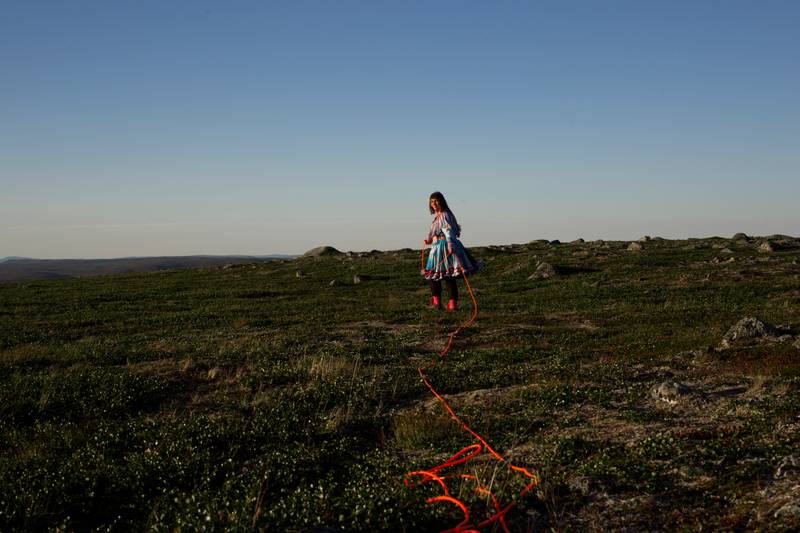

Ánnámáret, photo by Lada Suomenrinne, 2021
Sophia Mitiku (b.1995, California) is a singer, producer, and sound artist. Mitiku is easily recognizable by her explorative sound - gravitating between experimental RnB and avant-pop, she fluently crafts a liminal space of dreams and fantasy, nostalgia, and loss.
Ánnámáret is a musician and yoiker who belongs to the Arctic indigenous people, the Sámi. Her music could be described as dreams, nature, and soul spaces transmuted into melodies that express the feelings around these landscapes. Despite the unceremonial circumstance of chatting through flickering pixels and tinny voices over Google Meet, we found ourselves flowing effortlessly through topics of dreams, philosophy, identity, and spirituality. Weaving a fine gossamer between past, present, and future, our conversation held space to reflect on the influence of culture in music, its responsibilities, and how to conserve something while allowing it to develop.
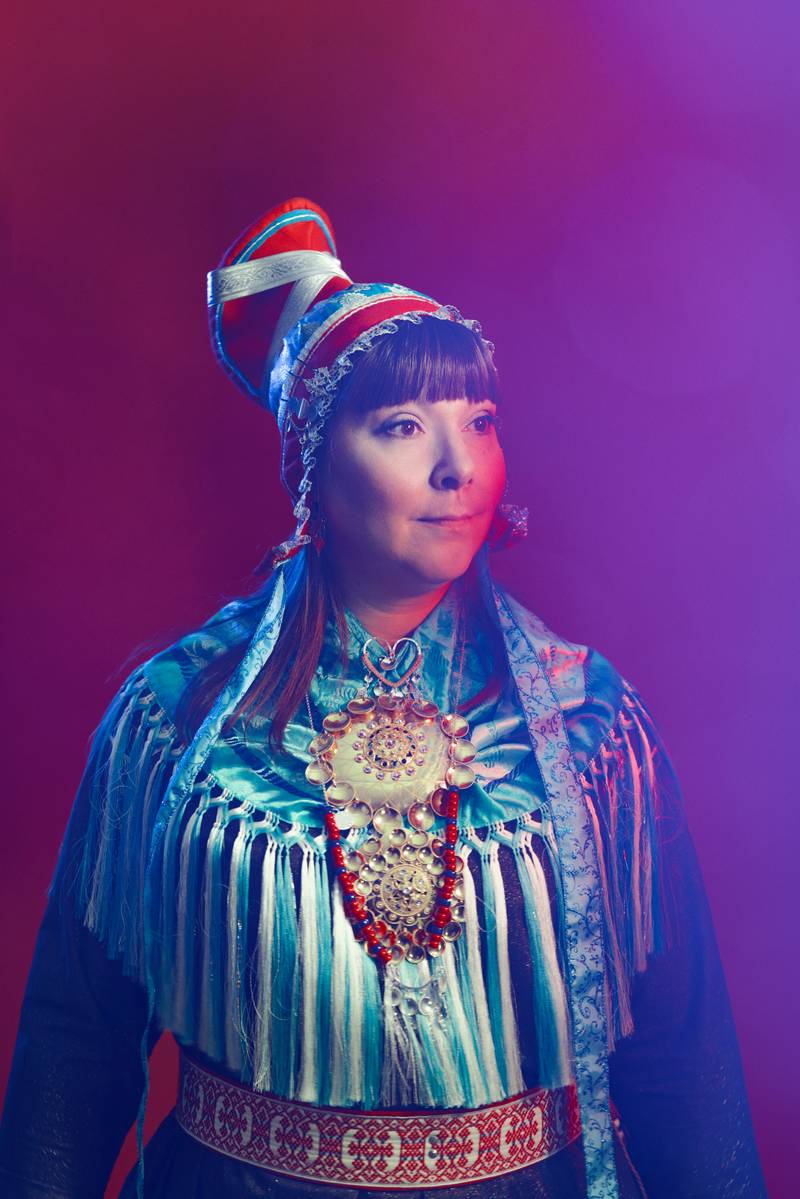

Ánnámáret. Photo by Maija Astikainen, 2023
SOPHIA: I was reading about yoiking [the traditional style of Sámi singing] and how one does not yoik about something or someone but rather yoiks them. What does this mean? And what is your process for writing a yoik?
ÁNNÁMÁRET: Yoiking, it’s said, is like hearing a musical portrait of a person or a picture. It can be done in many ways; maybe writing yoik is a modern way of doing it. Often, yoikers say it comes with the wind, and sometimes it does. But a yoik develops with the feeling. Those yoiks I made many years ago have changed and will continue to change. That is part of the tradition; they don’t stay the same. In that way, it is living and connected to people and nature.
You also work with archive material; can you open up your methods for this?
When using the archives, if you don’t know the people you are yoiking and you don’t understand the life they lived, their environment, or their society, then you can’t understand the lyrics very well. Somehow you have to adjust the archive material to this time. It is also important to have this process so you don’t just take the melody and start yoiking it. You have to have a relationship with the objective of the yoik. It’s part of the learning process. And you have to go through your own philosophical process. What does it mean that these yoiks are in the archive? And what does it mean when I start to yoik them? for me, my family, my community, etc? There are so many sides to consider, and it’s crucial that those who use the archive materials think about them—the problematics and, of course, the joy we have in this wonderful tradition. We have to think deeply about this understanding of collective ownership.
Art and culture are always in a state of regeneration, which can be quite delicate and should be treated with care and intention when considering how we continue cultural memory. What do you hear within the zeitgeist of Sámi music now?
Sámi artists sing and yoik about Sámi rights all the time, and they have been doing so since Sámi popular music started developing in the 1960s. So that’s a big theme in Sámi art. Colonialism - how to decolonize and how to build up the Sámi identity. That’s not something that has always been there. We’ve had smaller communities, and maybe they didn’t see the overall picture of the Sámi, so that’s a more modern idea to understand that we are one united people, not individual communities. That needs to be built up, mainly because we live in these four countries, which affects us so much. The country we live in, the school system, the legal system…we are always searching for that connection between the Sámis of other countries. This identity-building is probably a never-ending story.
Geopolitical borders must restrain this quite a lot.
Yes. Like, I can see Norway from my living room. And the same people live across the river, but we have this border. Because of politics and assimilation, the language has disappeared for many people and areas. Often, people speak Norwegian or Finnish, not Sámi. When this is lost, we have a gap because we don’t share the same language, which takes us in different directions. We are constantly fighting against these colonial structures.
It’s crucial that those who use the archive materials think about them—the problematics and, of course, the joy we have in this wonderful tradition. We have to think deeply about this understanding of collective ownership.
There is a different need for preservation when it’s essential for the survival of a diaspora, culture, language, etc. But I’ve been reflecting on decolonizing how we practice documenting and preservation, how to be a vessel for history rather than needing to capture it. If music can be a tool for this, what do you hope to conserve in your artistic practices?
There is always this question of culture and the philosophy of life. If you learn the language, it is not certain you will learn the philosophy. I have this project going on about Sámi spirituality. How can we still see it in our ordinary lives? The things I find are very connected to nature; living with nature, hunting, herding, and fishing, and doing them in a way that is symbiotic with nature, understanding the world from the Sámi perspective. That’s the starting point, and then you can start to preserve things. But it is essential to understand the philosophy. We have this special connection between people and reindeer; it is almost like a holy animal. It gives us life and makes living in this arctic area possible. It’s the most precious thing. To understand how we see and concretize these things, you must live in the communities and understand Sámi culture. Indigenous peoples have their language, culture, political systems, and religion, and I think this is our religion – being one with nature and people. We must learn this, not only the language or technical yoiking.
Do you ever feel a contradiction between your cultural/communal and artistic identities?
My communal identity is saying: Why are you doing this? Why aren’t you just taking care of the kids, sewing traditional clothes, and helping your family live an everyday Sámi life? But I am an artist, and I need to express things. In the Sámi community, I think we have this idea that it’s not good to tell everything. If you tell everything, it disappears. So how can I do this artistic thing without exposing everything? There is a bit of a dilemma. But the yoiks that I make are not personal yoiks. I use the musical style from there, but then I yoik about more abstract things. Without telling so much, I’m just yoiking from my experience, which makes it mine.
What are some differences or similarities in how your music is heard and experienced within the Sámi community versus outside?
This professor, Veli-Pekka Lehtonen, says Sámi art communicates on two levels. You can consume it as an insider or an outsider. There is yoiking inside a society where everybody knows each other and they can share things through yoik - but when it is on a stage, in a public place, in an arena, in a concert, or even in education, then the yoik changes quite a lot, and this communicative aspect disappears a little bit.
There tends to be a paradox of being marginalized and commercialized at the same time; artists and entertainers often face this position. How do you navigate that? Is this something you feel when performing in Finland?
I’m in a box: the ‘Sámi yoiker’ or ‘Sámi musician’ box. I’m not on the same level as Finnish pop musicians or classical artists - I’m in the Sámi box. In Finland, roughly speaking, our music is visible when we have Sámi National Day on the 6th of February. Then we have concerts; we are needed for interviews, radio, and TV. But other than that, we are not visible. Unofficially, folk music festivals will only have one Sámi artist per year, for example. And when that person is booked, they don’t need any more. Of course, I benefit from being in that box because it makes my music special; it has a story behind it. It’s interesting for outsiders. But then, coming out of the box as a musician that would be appreciated on the same level as other Finnish musicians, that’s hard.
I feel that. There is also the pendulum between being political and being politicized.
Yes, of course, as a Sámi artist, it is always assumed that you’re talking about politics and Sámi rights. Because of your public position and profession as an artist, it’s automatic that you should be speaking about political things. As a Sámi artist, being on stage is always a political act. Because you are so visible. You are representing your people there when you’re wearing Sámi clothes. And you are yoiking, for God’s sake, you’re speaking the Sámi language in Finnish society. That’s always a political act, even if you don’t mean it to be. The responsibility for the Sámi people to do it well is one of the many burdens and positions you have as a Sámi artist.
You have an album titled ‘Dreamscapes’. I believe there is so much information in our dreams. Accessing that space can open up many dimensions, and I read somewhere that making music requires a prophetic relationship with sound. How do the thematics of dreams, visions, and intuition translate into your music?
Dreamscapes—it’s a concept of my inner world. In this Dreamscapes album, I used the archives as a starting point. That creates these thoughts like, why am I doing this? Why is it important to look back? Why do I have to know my ancestors and history? Even if it might be more beneficial for me to know how to fill out my tax announcement… or how to fix the snow scooter. This search for roots and family history is so far from ordinary life. It’s romantic. It’s like an illusion, this dream. So that’s what I try to yoik. But it’s not just beautiful; it is somehow ironic. Of course, times were not all rosy either, but it’s an understanding of the gap between the past and present and searching for that connection. This one yoik Dološ Niegut (Ancient Dreams) was for reindeer herders. What you dream about is the reindeer because it gives you life. But now that I’ve been yoiking it for many years, it’s also about reindeer herding nowadays. About how much it has changed, it’s been so tough living in arctic nature back then without electricity or anything we have now. So it has changed a lot, and it’s honoring them for being able to do that.
Transgenerational knowledge must be stored in our body, and music really penetrates that somatic space. Listening to your music reminded me of spiritual languages and mantras. There is something transcendental yet grounding in the repetition of melodic phrases. What is your relationship between spirituality and yoiking?
My band members joke that before a concert, I always say, “I have to go connect with the earth and search for the spirit.” Because there are no lyrics in the yoiks, I made them for the Nieguid Duovgadat (Dreamscapes) entity, and you just have to interpret the feeling through yoiking. You must feel it and mean it. Getting into that state of mind and spirituality is a big part. When my yoiks are these abstract feelings, phenomena, and pictures, I have to know the feeling to get the right interpretation. I’ve been thinking about spirituality because most of us don´t have concrete practices of Sámi old religion. Of course, we read about it, and maybe some still practice it. But by yoiking, repeating the same lines, going inside, and feeling, there could be a connection between old spirituality and practices and the yoiking we have now. The yoik still carries the ancient soundscapes. So it’s connected to old times when we still believed in the old gods and had our shamans and drums.
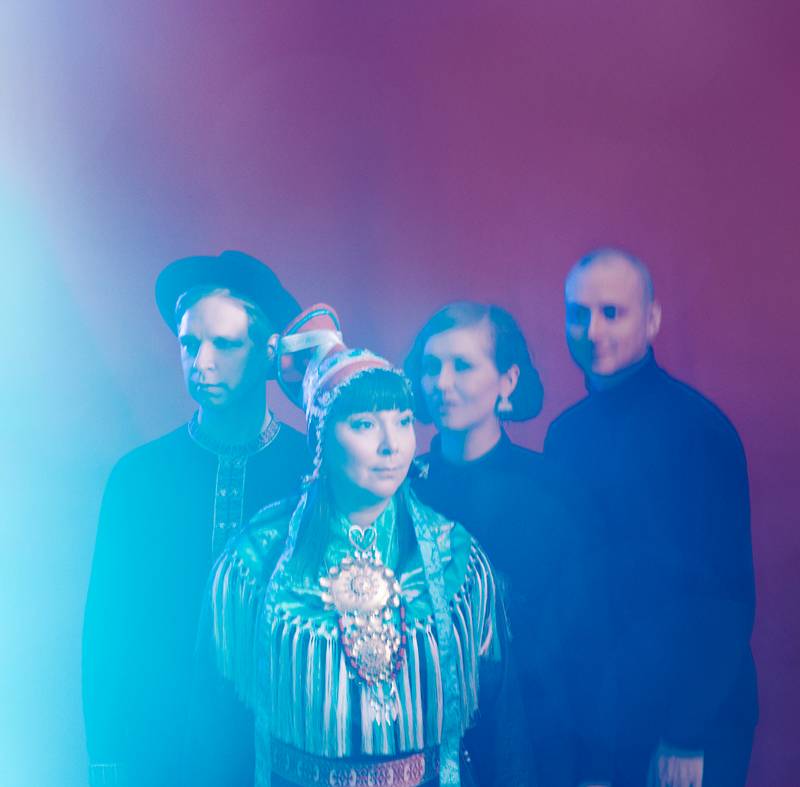

Ánnámáret 2023 with Dreamscapes band. Photo by Maija Astikainen
Where do you see the future of yoik and Sámi musical traditions? Where do you hope to take your practice?
I think it’s terrific that we have modern Sámi music and yoik in many forms combined with many different music genres. I only worry about losing the musical structures from the old yoik style. I’m interested in investigating how you can make music with western musicians without losing these musical features so much. We don’t have the same environment as 100 years ago – only hearing yoik. Everything we hear around us now affects our yoik. We live in popular music culture, and that’s our starting point. We have to unlearn popular music when learning yoik.
What is the purpose of continuing traditions when the environment changes or does not exist? Or how to even do this in an authentic way?
Do we have space for yoik in modern times anymore? But the purpose is to preserve the culture. And our way of thinking and living, our philosophy. It is in the yoik. The land is in the yoiks. The people, animals, and reindeers. Explaining the world in a Sámi way. This philosophy is important. The purpose is to try to preserve our culture and people. Every Sámi person has to do a little more than Finnish people.
Is there a particular philosophy that is present with you at the moment?
The meaning of land. As Mari Boine said: ‘land is our mother. If you harm it, you are harming yourself.’


